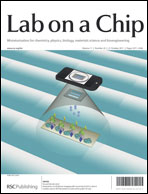Screening for circulating tumor cells (CTCs) in blood has been an object of interest for evidence of progressive disease, status of disease activity, recognition of clonal evolution of molecular changes and for possible early diagnosis of cancer. We describe a new method of microchip-based immunomagnetic CTC detection, in which the benefits of both immunomagnetic assay and the microfluidic device are combined. As the blood sample flows through the microchannel closely above arrayed magnets, cancer cells labeled with magnetic nanoparticles are separated from blood flow and deposited at the bottom wall of the glass coverslip, which allows direct observation of captured cells with a fluorescence microscope. A polydimethylsiloxane (PDMS)-based microchannel fixed on a glass coverslip was used to screen blood samples. The thin, flat dimensions of the microchannel, combined with the sharp magnetic field gradient in the vicinity of arrayed magnets with alternate polarities, lead to an effective capture of labeled cells. Compared to the commercially available CellSearch™ system, fewer (25%) magnetic particles are required to achieve a comparable capture rate, while the screening speed (at an optimal blood flow rate of 10 mL h−1) is more than five times faster than those reported previously with a microchannel-based assay. For the screening experiment, blood drawn from healthy subjects into CellSave™ tubes was spiked with cultured cancer cell lines of COLO205 and SKBR3. The blood was then kept at room temperature for 48 hours before the screening, emulating the actual clinical cases of blood screening. Customized Fe3O4 magnetic nanoparticles (Veridex Ferrofluid™) conjugated to anti-epithelial cell adhesion molecule (EpCAM) antibodies were introduced into the blood samples to label cancer cells, and the blood was then run through the microchip device to capture the labelled cells. After capture, the cells were stained with fluorescent labelled anti-cytokeratin, DAPI and anti-CD45. Subsequent immunofluorescence images were taken for the captured cells, followed by comprehensive computer aided analysis based on fluorescence intensities and cell morphology. Rare cancer cells (from ∼1000 cells down to ∼5 cells per mL) with very low tumor cell to blood cell ratios (about 1 : 107 to 109, including red blood cells) were successfully detected. Cancer cell capture rates of 90% and 86% were demonstrated for COLO205 and SKBR3 cells, respectively.


 Please wait while we load your content...
Please wait while we load your content...